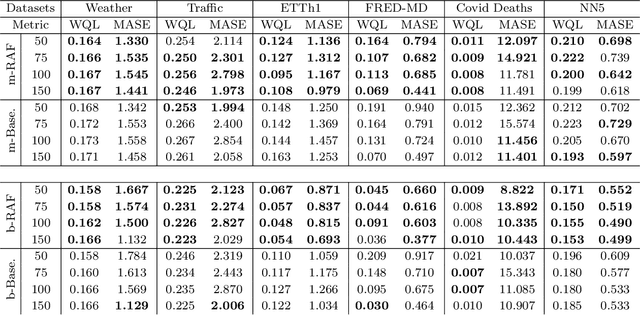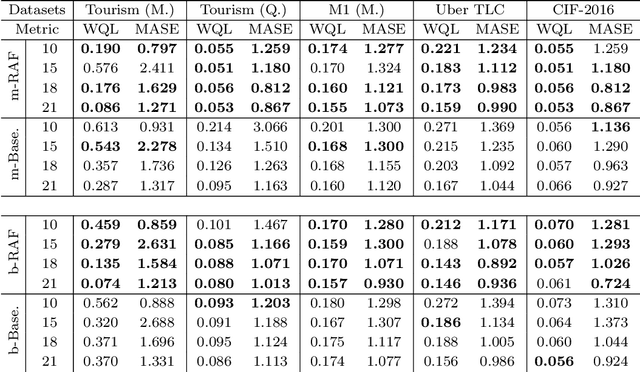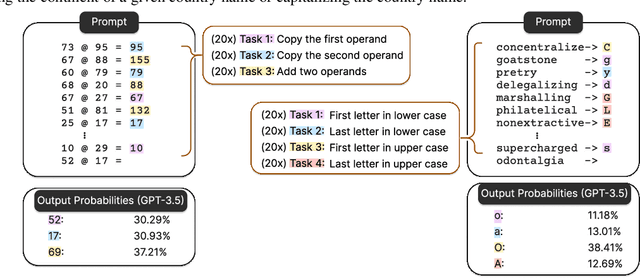Samet Oymak
Gating is Weighting: Understanding Gated Linear Attention through In-context Learning
Apr 06, 2025Abstract:Linear attention methods offer a compelling alternative to softmax attention due to their efficiency in recurrent decoding. Recent research has focused on enhancing standard linear attention by incorporating gating while retaining its computational benefits. Such Gated Linear Attention (GLA) architectures include competitive models such as Mamba and RWKV. In this work, we investigate the in-context learning capabilities of the GLA model and make the following contributions. We show that a multilayer GLA can implement a general class of Weighted Preconditioned Gradient Descent (WPGD) algorithms with data-dependent weights. These weights are induced by the gating mechanism and the input, enabling the model to control the contribution of individual tokens to prediction. To further understand the mechanics of this weighting, we introduce a novel data model with multitask prompts and characterize the optimization landscape of learning a WPGD algorithm. Under mild conditions, we establish the existence and uniqueness (up to scaling) of a global minimum, corresponding to a unique WPGD solution. Finally, we translate these findings to explore the optimization landscape of GLA and shed light on how gating facilitates context-aware learning and when it is provably better than vanilla linear attention.
Test-Time Training Provably Improves Transformers as In-context Learners
Mar 14, 2025Abstract:Test-time training (TTT) methods explicitly update the weights of a model to adapt to the specific test instance, and they have found success in a variety of settings, including most recently language modeling and reasoning. To demystify this success, we investigate a gradient-based TTT algorithm for in-context learning, where we train a transformer model on the in-context demonstrations provided in the test prompt. Specifically, we provide a comprehensive theoretical characterization of linear transformers when the update rule is a single gradient step. Our theory (i) delineates the role of alignment between pretraining distribution and target task, (ii) demystifies how TTT can alleviate distribution shift, and (iii) quantifies the sample complexity of TTT including how it can significantly reduce the eventual sample size required for in-context learning. As our empirical contribution, we study the benefits of TTT for TabPFN, a tabular foundation model. In line with our theory, we demonstrate that TTT significantly reduces the required sample size for tabular classification (3 to 5 times fewer) unlocking substantial inference efficiency with a negligible training cost.
Identifying Trustworthiness Challenges in Deep Learning Models for Continental-Scale Water Quality Prediction
Mar 13, 2025Abstract:Water quality is foundational to environmental sustainability, ecosystem resilience, and public health. Deep learning models, particularly Long Short-Term Memory (LSTM) networks, offer transformative potential for large-scale water quality prediction and scientific insights generation. However, their widespread adoption in high-stakes decision-making, such as pollution mitigation and equitable resource allocation, is prevented by unresolved trustworthiness challenges including fairness, uncertainty, interpretability, robustness, generalizability, and reproducibility. In this work, we present the first comprehensive evaluation of trustworthiness in a continental-scale multi-task LSTM model predicting 20 water quality variables (encompassing physical/chemical processes, geochemical weathering, and nutrient cycling) across 482 U.S. basins. Our investigation uncovers systematic patterns of model performance disparities linked to basin characteristics, the inherent complexity of biogeochemical processes, and variable predictability, emphasizing critical performance fairness concerns. We further propose methodological frameworks for quantitatively evaluating critical aspects of trustworthiness, including uncertainty, interpretability, and robustness, identifying key limitations that could challenge reliable real-world deployment. This work serves as a timely call to action for advancing trustworthy data-driven methods for water resources management and provides a pathway to offering critical insights for researchers, decision-makers, and practitioners seeking to leverage artificial intelligence (AI) responsibly in environmental management.
Provable Benefits of Task-Specific Prompts for In-context Learning
Mar 05, 2025Abstract:The in-context learning capabilities of modern language models have motivated a deeper mathematical understanding of sequence models. A line of recent work has shown that linear attention models can emulate projected gradient descent iterations to implicitly learn the task vector from the data provided in the context window. In this work, we consider a novel setting where the global task distribution can be partitioned into a union of conditional task distributions. We then examine the use of task-specific prompts and prediction heads for learning the prior information associated with the conditional task distribution using a one-layer attention model. Our results on loss landscape show that task-specific prompts facilitate a covariance-mean decoupling where prompt-tuning explains the conditional mean of the distribution whereas the variance is learned/explained through in-context learning. Incorporating task-specific head further aids this process by entirely decoupling estimation of mean and variance components. This covariance-mean perspective similarly explains how jointly training prompt and attention weights can provably help over fine-tuning after pretraining.
TimePFN: Effective Multivariate Time Series Forecasting with Synthetic Data
Feb 22, 2025Abstract:The diversity of time series applications and scarcity of domain-specific data highlight the need for time-series models with strong few-shot learning capabilities. In this work, we propose a novel training scheme and a transformer-based architecture, collectively referred to as TimePFN, for multivariate time-series (MTS) forecasting. TimePFN is based on the concept of Prior-data Fitted Networks (PFN), which aims to approximate Bayesian inference. Our approach consists of (1) generating synthetic MTS data through diverse Gaussian process kernels and the linear coregionalization method, and (2) a novel MTS architecture capable of utilizing both temporal and cross-channel dependencies across all input patches. We evaluate TimePFN on several benchmark datasets and demonstrate that it outperforms the existing state-of-the-art models for MTS forecasting in both zero-shot and few-shot settings. Notably, fine-tuning TimePFN with as few as 500 data points nearly matches full dataset training error, and even 50 data points yield competitive results. We also find that TimePFN exhibits strong univariate forecasting performance, attesting to its generalization ability. Overall, this work unlocks the power of synthetic data priors for MTS forecasting and facilitates strong zero- and few-shot forecasting performance.
Selective Attention: Enhancing Transformer through Principled Context Control
Nov 19, 2024



Abstract:The attention mechanism within the transformer architecture enables the model to weigh and combine tokens based on their relevance to the query. While self-attention has enjoyed major success, it notably treats all queries $q$ in the same way by applying the mapping $V^\top\text{softmax}(Kq)$, where $V,K$ are the value and key embeddings respectively. In this work, we argue that this uniform treatment hinders the ability to control contextual sparsity and relevance. As a solution, we introduce the $\textit{Selective Self-Attention}$ (SSA) layer that augments the softmax nonlinearity with a principled temperature scaling strategy. By controlling temperature, SSA adapts the contextual sparsity of the attention map to the query embedding and its position in the context window. Through theory and experiments, we demonstrate that this alleviates attention dilution, aids the optimization process, and enhances the model's ability to control softmax spikiness of individual queries. We also incorporate temperature scaling for value embeddings and show that it boosts the model's ability to suppress irrelevant/noisy tokens. Notably, SSA is a lightweight method which introduces less than 0.5% new parameters through a weight-sharing strategy and can be fine-tuned on existing LLMs. Extensive empirical evaluations demonstrate that SSA-equipped models achieve a noticeable and consistent accuracy improvement on language modeling benchmarks.
Retrieval Augmented Time Series Forecasting
Nov 12, 2024



Abstract:Retrieval-augmented generation (RAG) is a central component of modern LLM systems, particularly in scenarios where up-to-date information is crucial for accurately responding to user queries or when queries exceed the scope of the training data. The advent of time-series foundation models (TSFM), such as Chronos, and the need for effective zero-shot forecasting performance across various time-series domains motivates the question: Do benefits of RAG similarly carry over to time series forecasting? In this paper, we advocate that the dynamic and event-driven nature of time-series data makes RAG a crucial component of TSFMs and introduce a principled RAG framework for time-series forecasting, called Retrieval Augmented Forecasting (RAF). Within RAF, we develop efficient strategies for retrieving related time-series examples and incorporating them into forecast. Through experiments and mechanistic studies, we demonstrate that RAF indeed improves the forecasting accuracy across diverse time series domains and the improvement is more significant for larger TSFM sizes.
High-dimensional Analysis of Knowledge Distillation: Weak-to-Strong Generalization and Scaling Laws
Oct 24, 2024Abstract:A growing number of machine learning scenarios rely on knowledge distillation where one uses the output of a surrogate model as labels to supervise the training of a target model. In this work, we provide a sharp characterization of this process for ridgeless, high-dimensional regression, under two settings: (i) model shift, where the surrogate model is arbitrary, and (ii) distribution shift, where the surrogate model is the solution of empirical risk minimization with out-of-distribution data. In both cases, we characterize the precise risk of the target model through non-asymptotic bounds in terms of sample size and data distribution under mild conditions. As a consequence, we identify the form of the optimal surrogate model, which reveals the benefits and limitations of discarding weak features in a data-dependent fashion. In the context of weak-to-strong (W2S) generalization, this has the interpretation that (i) W2S training, with the surrogate as the weak model, can provably outperform training with strong labels under the same data budget, but (ii) it is unable to improve the data scaling law. We validate our results on numerical experiments both on ridgeless regression and on neural network architectures.
Everything Everywhere All at Once: LLMs can In-Context Learn Multiple Tasks in Superposition
Oct 08, 2024



Abstract:Large Language Models (LLMs) have demonstrated remarkable in-context learning (ICL) capabilities. In this study, we explore a surprising phenomenon related to ICL: LLMs can perform multiple, computationally distinct ICL tasks simultaneously, during a single inference call, a capability we term "task superposition". We provide empirical evidence of this phenomenon across various LLM families and scales and show that this phenomenon emerges even if we train the model to in-context learn one task at a time. We offer theoretical explanations that this capability is well within the expressive power of transformers. We also explore how LLMs internally compose task vectors during superposition. Furthermore, we show that larger models can solve more ICL tasks in parallel, and better calibrate their output distribution. Our findings offer insights into the latent capabilities of LLMs, further substantiate the perspective of "LLMs as superposition of simulators", and raise questions about the mechanisms enabling simultaneous task execution.
Fine-grained Analysis of In-context Linear Estimation: Data, Architecture, and Beyond
Jul 13, 2024Abstract:Recent research has shown that Transformers with linear attention are capable of in-context learning (ICL) by implementing a linear estimator through gradient descent steps. However, the existing results on the optimization landscape apply under stylized settings where task and feature vectors are assumed to be IID and the attention weights are fully parameterized. In this work, we develop a stronger characterization of the optimization and generalization landscape of ICL through contributions on architectures, low-rank parameterization, and correlated designs: (1) We study the landscape of 1-layer linear attention and 1-layer H3, a state-space model. Under a suitable correlated design assumption, we prove that both implement 1-step preconditioned gradient descent. We show that thanks to its native convolution filters, H3 also has the advantage of implementing sample weighting and outperforming linear attention in suitable settings. (2) By studying correlated designs, we provide new risk bounds for retrieval augmented generation (RAG) and task-feature alignment which reveal how ICL sample complexity benefits from distributional alignment. (3) We derive the optimal risk for low-rank parameterized attention weights in terms of covariance spectrum. Through this, we also shed light on how LoRA can adapt to a new distribution by capturing the shift between task covariances. Experimental results corroborate our theoretical findings. Overall, this work explores the optimization and risk landscape of ICL in practically meaningful settings and contributes to a more thorough understanding of its mechanics.
 Add to Chrome
Add to Chrome Add to Firefox
Add to Firefox Add to Edge
Add to Edge